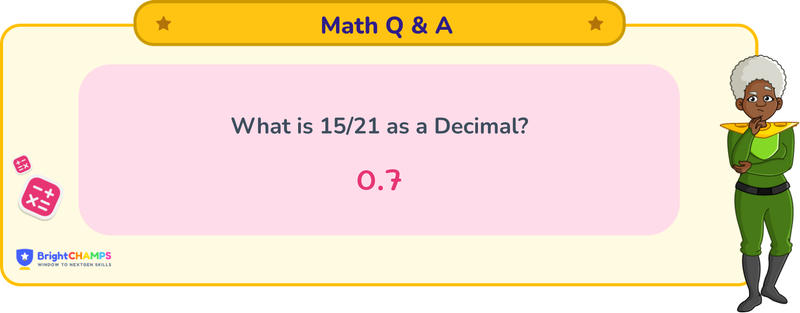Summarize this article:
 211 Learners
211 LearnersLast updated on 5 August 2025
15/21 as a Decimal

It is a simple question on decimal conversion. Firstly, we have to understand fractions and decimals. A fraction represents a part of a whole. It has two parts: the numerator (the number on the top), here, 15, which indicates how many parts out of the whole. The denominator (the number below) shows how many parts make up the whole, here it is 21. A decimal is a way to represent a number that is not whole, using a (.) or a decimal point to separate the whole part from the fractional part. The numbers to the left of the decimal point represent the whole, and those to the right represent the fractional part.

What is 15/21 as a decimal?

Answer
15/21 in decimals can be simplified and then written as approximately 0.71428. This is not a recurring decimal as it eventually terminates.
Explanation
To convert 15/21 into a decimal, we first simplify the fraction and then use division. Let's see the step-by-step breakdown of the process:
Step 1: Simplify the fraction. Both 15 and 21 can be divided by their greatest common divisor, which is 3. So, 15/21 simplifies to 5/7.
Step 2: Identify the simplified numerator and denominator because the numerator (5) will be taken as the dividend and the denominator (7) will be taken as the divisor.
Step 3: Divide 5 by 7 using long division. As 5 is smaller than 7, we add a decimal point and a 0 to make it 50.
Step 4: Determine how many times 7 fits into 50, which is 7 times (7 x 7 = 49). Write 7 in the quotient place and subtract 49 from 50 to get 1.
Step 5: Bring down another 0, making it 10, and repeat the division process.
Step 6: Continue the process until you get a remainder of 0 or decide to stop at a certain decimal place.
The answer for 15/21 as a decimal is approximately 0.71428.

Important Glossaries for 15/21 as a decimal
- Fraction: A numerical quantity that is not a whole number, representing a part of a whole.
- Decimal: A number that uses base ten and includes a decimal point to separate the whole part from the fractional part.
- Numerator: The top part of a fraction, indicating how many parts of the whole are being considered.
- Denominator: The bottom part of a fraction, showing how many parts make up a whole.
- Simplification: The process of reducing a fraction to its simplest form by dividing both the numerator and the denominator by their greatest common divisor.

Explore More math-questions
![Important Math Links Icon]() Previous to 15/21 as a Decimal
Previous to 15/21 as a Decimal
![Important Math Links Icon]() Next to 15/21 as a Decimal
Next to 15/21 as a Decimal





